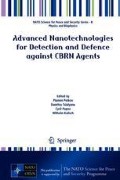Abstract
Silver nanoparticles (AgNPs) were successfully synthesized via a bottom-up approach by using aqueous extract of lantana camara (LC) leaves as reducing and stabilizing agent. Characterization studies were done using UV-Vis spectroscopy and Fourier Transform Infrared Spectroscopy (FTIR). The average size, morphology and shape of the nanoparticles were determined by Scanning Electron Microscopy (SEM) and Dynamic Light Scattering (DLS). A light brown color indicated the synthesis of AgNPs, caused by a surface plasmon resonance (SPR) peak at 460 nm. The silver nanoparticles were used to detect mercury (Hg2+) ions. A color change of the AgNPs solution from light brown to cloudy white due to oxidation of Ag0 to Ag+1 ions was observed. A good selectivity of the AgNPs towards mercury ions in water has been obtained. This method was found to be simple and rapid for detection of Hg2+ ions and demonstrated a potential to be used in environmental colorimetric sensor applications.
Access this chapter
Tax calculation will be finalised at checkout
Purchases are for personal use only
References
Cheon JY, Park WH (2016) International Journal of Molecular Sciences, Green synthesis of silver nanoparticles stabilized with mussel-inspired protein and colorimetric sensing of lead(II) and copper(II) ions. Int. J. Mol. Sci. 17:1–10
Tchounwou PB, Yedjou CG, Patlolla AK, Sutton DJ (2012) Heavy metals toxicity and the environment. NIH Public Access 101:133–164
Ahmed MH, Hasan N, Mohiuddin S (2014) Silver nanoparticles: green synthesis,characterization, and their usage in determination of mercury contamination in seafoods. ISRN Nanotechnol 2014:1–5
Annadhasan M, Muthukumarasamyvel T, Sankar Babu VR, Rajendiran N (2014) Green synthesized silver and gold nanoparticles for colorimetric detection of Hg2+, Pb2+, and Mn2+ in aqueous medium. ACS Sustain Chem Eng 2:887–896
Lokhande C, Shinde NM, Shelke A, Babar PT, Kim JH (2017) Reliable and reproducible colorimetric detection of mercury ions (Hg2+) using green synthesized optically active silver nanoparticles containing thin film on flexible plastic substrate. J Solid State Electrochem. 21:2747–2751
Balashanmugam P, Kalaichelvan PT (2015) Biosynthesis characterization of silver nanoparticles using Cassia roxburghii DC. aqueous extract, and coated on cotton cloth for effective antibacterial activity. Int J Nanomedicine 10:87–97
Ihsan M, Niaz A, Rahim A, Zaman MI, Arain MB, Sirajuddin TS, Najeeba M (2015) Biologically synthesized silver nanoparticle-based colorimetric sensor for the selective detection of Zn2+. RSC Advances 5:91158–91165
Dash SS, Bag BG, Hota P (2015) Lantana camara Linn leaf extract mediated green synthesis of gold nanoparticles and study of its catalytic activity. Appl Nanosci 5:343–350
Anandalakshmi K, Venugobal J, Ramasamy V (2016) Characterization of silver nan particles by green synthesis method using Pedalium murex leaf extract and their antibacterial activity. Appl Nanosci 6:399–408
Mohanta YK, Panda SK, Biswas K, Tamang A, Bandyopadhyay J, De D, Mohanta D, Bastia AK (2016) Biogenic synthesis of silver nano-particles from Cassia fistula (Linn.): in vitro assessment of their antioxidant, antimicrobial and cytotoxic activities. IET Nanobiotechnol 10:438–444
Author information
Authors and Affiliations
Corresponding author
Editor information
Editors and Affiliations
Rights and permissions
Copyright information
© 2018 Springer Science+Business Media B.V., part of Springer Nature
About this paper
Cite this paper
Demir, D., Bölgen, N., Vaseashta, A. (2018). Green Synthesis of Silver Nanoparticles Using Lantana Camara Leaf Extract and Their Use as Mercury(II) Ion Sensor. In: Petkov, P., Tsiulyanu, D., Popov, C., Kulisch, W. (eds) Advanced Nanotechnologies for Detection and Defence against CBRN Agents. NATO Science for Peace and Security Series B: Physics and Biophysics. Springer, Dordrecht. https://doi.org/10.1007/978-94-024-1298-7_42
Download citation
DOI: https://doi.org/10.1007/978-94-024-1298-7_42
Published:
Publisher Name: Springer, Dordrecht
Print ISBN: 978-94-024-1297-0
Online ISBN: 978-94-024-1298-7
eBook Packages: Physics and AstronomyPhysics and Astronomy (R0)

